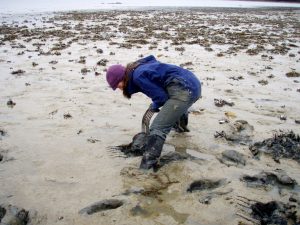Are Some Shellfish Beds and Beaches Closed Needlessly? Mitchell Center Scientists Take a Closer Look
 Could Northeast shellfish fisheries and beaches along Maine’s coast have fewer contaminated areas than currently reflected in closures and advisories? The possibility is being examined by scientists looking for methods to test the areas in question with greater precision.
Could Northeast shellfish fisheries and beaches along Maine’s coast have fewer contaminated areas than currently reflected in closures and advisories? The possibility is being examined by scientists looking for methods to test the areas in question with greater precision.
Maine, New Hampshire and other New England states close thousands of acres of shellfish fisheries every year, due in part to contamination by fecal bacteria. A multi-institutional group of researchers is looking for ways to more accurately determine which specific spots in these vast closures actually have dangerous levels of fecal coliform bacteria.
The team is looking at beach advisory data as well, working closely with the Maine Healthy Beaches Program. Advisories are issued when levels of enterococci bacteria are deemed too high for safe swimming.
Using geographic information systems and data gathered over multiple years by Maine’s Department of Marine Resources (DMR), researchers are investigating multiple factors – rainfall, salinity, concentration of development – to pinpoint trouble spots across vast watery acreage. The how and why is a complex puzzle. Scientists are seeking answers in patterns of space and time. See more…
